The toughest spot for growing plants in a desert garden is near a heat-reflecting wall. Here are 16 shrubs that not only thrive in reflected heat but reward you with beautiful flowers!

The hot, dry desert climate can be hard on plants. And the toughest spot in the garden is one that gets reflected heat. You know the spots — next to a house or a wall that has the sun beating on it all day long.
I’ve checked the surface temperatures of my house and garden walls with my infrared thermometer gun and have found them to be as hot as 180℉! No plant living in the wild has to face the unnatural burden of growing next to heat-radiating man-made surfaces like our garden plants do.
Since most houses in southern Arizona have yards surrounded at least in part by block or stucco walls, one of the most common questions I hear is “What can I plant near a hot, sunny wall?”
You might think you’ll be limited to desert workhorses like cactus, but this turns out to not be true. There are a surprising number of attractive shrubs that grow quite happily next to a house or even a west-facing wall — the hottest place of all. In fact, many of these shrubs prefer intense sun over part shade.
A surprising source of reflected heat is the glare
from windows which can melt artificial turf! 😮
Here’s a look at some of the super-resilient shrubs that can thrive in the hottest spots in your yard and reward you with a rainbow of beautiful flowers!
Baja Fairy Duster
Baja fairy duster (Calliandra californica) is a lacy evergreen shrub that’s adorned with charming red flowers. It’s one of the few plants that blooms all four seasons in desert gardens, making it an important year-round food source for hummingbirds and other pollinators.
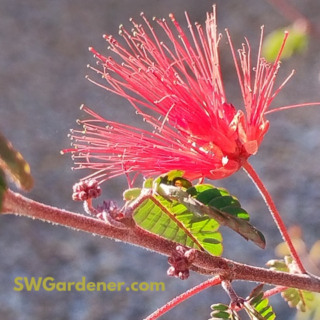
Bougainvillea
Bougainvillea (Bougainvillea spp.) is a genus of scrambling woody vines native to South America. These plants need little care and bloom profusely from spring through the first frost. They are semi-deciduous, losing their leaves with the first freeze. Be mindful when pruning since they are covered with substantial thorns.
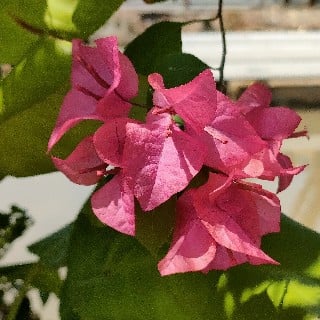
Brittlebush
Brittlebush (Encelia farinosa) is so common in the Sonoran Desert that you might not think of it as a landscape plant. But its silver-gray leaves and yellow daisy-like flowers provide a splash of color on and off throughout the year. It grows fast — from seedling to a few feet tall in just a few months. If you’re lucky you might find a volunteer growing along your wall, since birds eat and disperse the seeds.
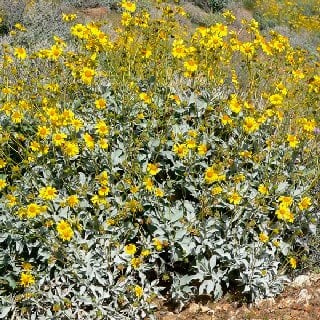
Creosote
If you’ve spent a summer in the desert, you are probably familiar with creosote (Larrea tridentata), an extremely tough desert native that smells like the desert when it rains. This informal shrub gets covered with dainty yellow flowers followed by white fuzzy seed pods. You’ll find this plant at nurseries that specialize in native plants.

Emu Bushes
Eremophila is a genus of drought-tolerant Australian shrubs with flowers shaped like tiny lipstick tubes. Some emu bushes commonly sold in the US include: Valentine (E. maculata ‘Valentine’), Easter egg (E. racemosa), Winter Blaze (E. glabra ssp. carnosa), Outback Sunrise (Eremophila glabra ‘Mingenew Gold’), and Blue Bells (E. hygrophana ‘Blue Bells’). You can often find them at Lowes or Home Depot which partner with Australian Outback Plantation wholesalers.
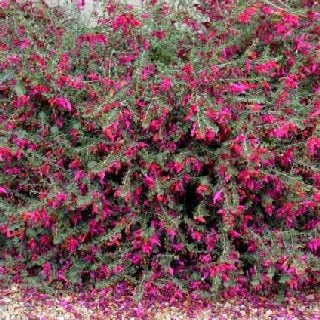
Fairy Duster
Fairy duster (Calliandra eriophylla) is a delicate-looking plant that’s a tough southwest native. It has puffy pink flowers, wiry stems, and lacy, fern-like leaves that close at night. In its native habitat, it exists on as little as 3 inches of annual rainfall and survives temperatures in the low teens.

Globe Mallow
Globe mallow (Sphaeralcea ambigua) is a super-resilient shrub that usually has orange flowers, but also comes in a rainbow assortment including white, lavender, magenta, pink, and red. This extremely resilient plant is often found growing alongside some of the toughest desert shrubs including creosote and brittlebush.

Indian Mallow
Indian mallow (Abutilon palmeri) is an evergreen southwest desert native with an open, airy form. It has silver-gray, heart-shaped leaves that are relatively large for a desert native. It’s covered with orange poppy-like flowers most of the year. It’s also called Superstition mallow since its range includes the Superstition Mountains.
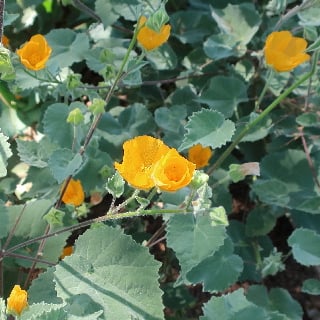
Lady Bank’s Rose
When it comes to roses, Lady Banks rose (Rosa banksiea) is in a class of its own. While it’s possible to grow roses in the desert, they can be challenging. Not so with Lady Banks. This sprawling vine-like shrub grows fast to cover a blank wall with a cascade of white or yellow roses every spring.
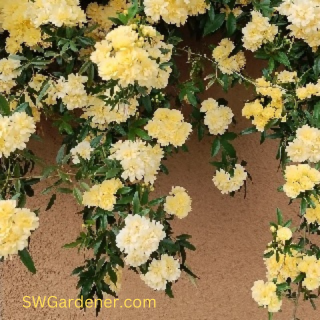
Fun Fact!
The largest rose in the world is a Lady Bank’s rose
that grows in Tombstone, Arizona.
Little Leaf Cordia
Little leaf cordia (Cordia parvifolia) is an extremely hardy, sprawling shrub that’s adorned with snow-white flowers, a rare color in the desert. It really stands out in mid-to-late summer, since it’s at its best when many plants are looking tired. This informal shrub is native to southern Arizona and parts of Mexico.

Pomegranate
Pomegranate (Punica granatum) is a Middle East native that thrives in desert conditions. This large shrub is more than a source of fruit, it’s a gorgeous landscape plant that offers visual interest all year — vivid orange-red flowers in the spring, apple-like fruits in the summer, and golden yellow leaves in the fall.
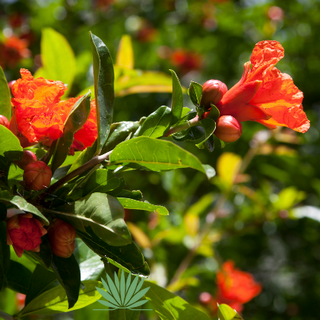
Red Bird of Paradise
Red bird of paradise (Caesalpinia pulcherrima) is a large, exotic-looking shrub with dramatic, vibrant flowers. It flowers just as the monsoon kicks in, giving a splash of color just when many plants are taking a break from producing flowers. This West Indies native has naturalized in the desert southwest.

Texas Olive
Texas olive (Cordia boissieri) is native to Texas, but it’s not related to olive trees. It can be grown as either a large evergreen shrub or small tree, depending on how it’s pruned. It has large, leathery leaves and big, white ruffled flowers. After it blooms, it produces non-edible seeds that look somewhat like olives.

Texas Ranger
Texas ranger (Leucophyllum frutescens) is an extremely hardy desert shrub with show-stopping lavender flowers. It comes in numerous varieties, which differ in size and color, but are all equally tolerant of reflective heat. This desert native needs very little care, but it does need plenty of room to grow to reveal its true beauty.
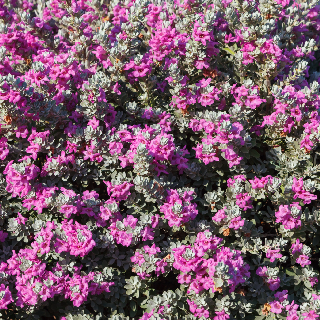
Yellow Bells
Yellow bells (Tecoma stans) is an exceptionally attractive shrub with large clusters of yellow flowers and bright green leaves. While it may look tropical, it’s native to the desert southwest. It’s not uncommon to see yellow bells thriving in parking lots, looking fresh and cheerful in spite of neglect.
Yellow bells has many popular hybrids including ‘Orange Jubilee,’ ‘Sparky,’ ‘Gold Star,’ and ‘Bells on Fire.’ They all thrive in reflected heat, too.

Woolly Butterfly Bush
Woolly butterfly bush (Buddleja marrubiifolia) lives up to its name. This shrub’s silvery gray leaves are woolly and butterflies flock to it when in bloom. Each marble size “flower” is actually a cluster of tiny orange flowers. For their size, they produce a lot of nectar that pollinators can’t resist. This evergreen shrub is a hardy Chihuahuan Desert native that makes a low-maintenance addition to your garden.
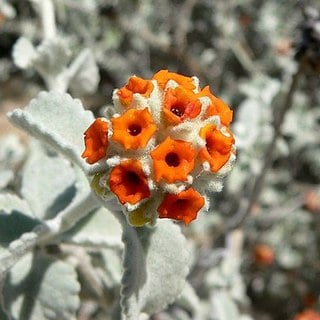
So now you’ve got a good selection to choose from. To learn more about any of these shrubs, click on the bold link of that plant’s name to read a comprehensive “plant profile” that will tell you everything you need to know about successfully growing that shrub. You may also find some interesting “fun facts” about that shrub, too. 😉
Oleander: One Flowering Shrub to Skip
I’m going to end this list with a popular (some say “overused“) shrub I hope you’ll skip — Oleander (Nerium oleander). This versatile Mediterranean native is fast-growing, withstands a wide variety of conditions, flowers profusely, and requires minimal care. However, it does have some serious issues you should consider before planting.

Oleanders are highly toxic and considered invasive in the southwest. They offer no benefit to pollinators and are prone to a new deadly disease, oleander leaf scorch. These large plants have robust root systems that can damage foundations, garden walls, patios, and water lines. And once established, they are nearly impossible to get rid of. For these reasons, I hope you’ll consider one of these other superior plants on this list instead.
Did you enjoy this article?
Sign up for our weekly newsletter
where you’ll find more great info on creating &
maintaining a beautiful, carefree desert landscape.
Author Bio
Deane Alban is the creator of Southwest Gardener. She is a science writer with a bachelor’s degree in botany from the University of South Florida. Gardening is her lifelong passion. She’s been gardening in Tucson for over 15 years.

Photo Credits
Vitaium, CC BY-SA 4.0, via Wikimedia Commons
“Palmer’s Indian Mallow” by KM is licensed under CC BY 2.0
Challiyan, CC BY 3.0, Wikimedia Commons
Mountain States Wholesale Nursery
Arizona State University’s Virtual Library of Phoenix Landscape Plants
